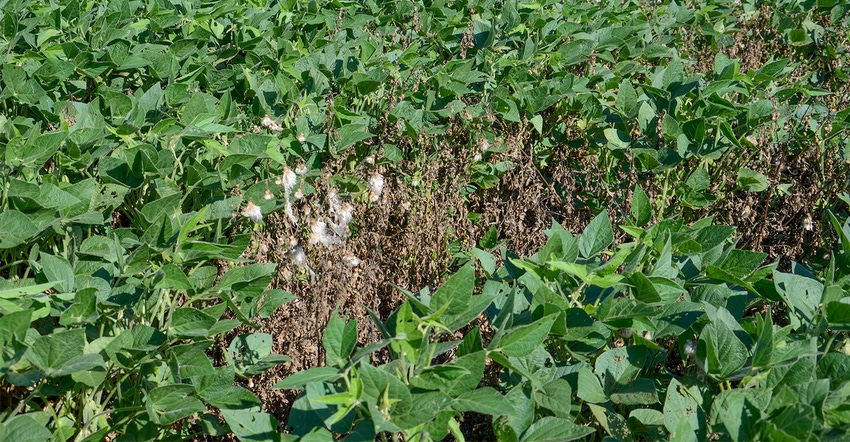
The good news in the Soybean Watch ’17 field is that Canada thistles that poked their heads above the soybean canopy in midsummer were controlled effectively when the farmer was finally able to make a postemergence herbicide application. The not-so-good news is that rains and wet soils delayed the application and gave the thistles longer to compete with the crop.
“This was one of those yeas where weather played a huge role in when crops could be planted, whether or not they were affected by slugs, and when herbicides could be sprayed,” says Steve Gauck, a sales agronomist for Beck’s, based near Greensburg, Ind. Soybean Watch ’17 is sponsored by Beck’s.
The Soybean Watch field received a triple whammy, Gauck says. Wet soils delayed planting until June 6. Slugs persisted much longer into the season than normal, thinning the stand. Finally, weeds — particularly Canada thistles — were well-established after a huge rain in early July prevented a timely post herbicide application. How much these factors will affect yields remains to be seen.
“There is still an adequate stand of 80,000 or more plants, even in the spots where slugs were worst,” Gauck says. “Several fields planted earlier had to be replanted, some more than once.”
Weed control
When the application could finally be made, glyphosate and Cadet did a number on Canada thistles, Gauck observes. There was some evidence of light burning on soybean leaves, but Gauck doesn’t believe it will affect yield in the long run.
What’s harder to measure, he notes, is whether thistles, where they were thickest, hurt yields before they were controlled. “Some of those areas looked green, but after the thistles turned brown, there wasn’t as much green left,” he says. “The stand of soybeans didn’t look as thick after the thistles were removed.
Earlier, Gauck compared a plant growing where thistles were thick to one where there were no thistles. The one growing without weeds produced more branches, and those branches produced pods.
University studies have been done on the effects of weeds competing with soybeans, but most were done years ago with weeds like pigweed, velvetleaf and giant foxtail. They aren’t as competitive as some weeds farmers battle today, such as marestail and tall waterhemp.
Based on those early studies, summarized in the Purdue University Corn & Soybean Field Guide, early weed infestations can do considerable damage to potential yield. One pigweed per 10 foot of row reduced yields 30%. If there were eight pigweeds per 10 foot of row before they were controlled, only 44% of normal yield was expected.
Giant foxtail wasn’t as damaging, with 60 per 10 foot of row still producing 87% of yield. However, six velvetleaf plants per 10 foot of row dropped yield potential to just under 50% of normal.
The other factor is adding seed to the seed bank, Gauck says. “You want to control weeds before they go to seed,” he says. “This was just a tough year to accomplish that in some cases.”
About the Author(s)
You May Also Like




